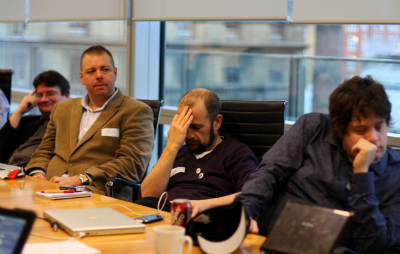I don’t know where this story ends. I know where it starts though.
At various times since the dawn of technology-enabled government – since information about some of the big things in your life was held on computers – the cry goes out: “Why can’t we join all this up?” “Why do I have to keep telling government the same information time and time again?” “Why can’t I get at all the things that are important to me – all about ME – in one place?”
And other such variants. But you get the point – simple, obvious questions.
And as the years have ticked by, the progress made towards answering these questions has been…well, shabby, to say the least. Especially in proportion to the money that’s been spent in this area.
We’ve had talk of passports, of portals, of “Tell Us Once”, of Citizen Accounts. Of Gateways, single identifiers, and now, MyGov.
None of them, with the exception of the last one – for whom it’s too early to tell – have done very well. (Online, anyway. Tell Us Once has apparently being doing quite well in face-to-face service pilots.)
Isn’t that interesting? Simple questions. Obvious goals. But never any progress. Ah – the wise will say – that’s just because nobody in government wants to change. There are all these vested interests. We’d have to rewire the way everything worked. And – say the privacy campaigners – do you realise what you’re also doing here? Creating an environment where a future totalitarian government can control everything you do from that one place – and where the loss of that single picture of you would make your life completely unmanageable until it got sorted out again.
I’ll argue that there’s an even more obvious reason why progress falters and eventually stalls. Time after time.
Temptation.
The temptation to believe that such easy questions must have simple answers, and to keep on searching for them in the same way over and over again. Usually by starting with a simple model, getting frustrated by how quickly it gets complicated, then abandoning the work and starting with another simple model. Rather than the harder task.
Which is to ask: what’s the actual goal of this ‘personalisation’? For it’s really not as obvious as it may seem.
Some of you may stop reading at this point. Or find yourselves wanting to dodge the difficult questions. “Why make this more complicated than it needs to be?” you may think. Why, indeed? “Surely the goal is to make things simpler for the citizen, and less expensive for government? Like, durrr…”
The White Knight of Personalisation (and I’ve met a few over the years) generally says one of several stock things at this point. Here are a few of them: “All your data can be cross-referenced in any case by government: why the hang-up? Just accept this and build everything around one identifier, hey how about the National Insurance number?” “Let’s just do an account that doesn’t hold personal data, then we don’t need to make it too complicated.” “Ok, let’s start from scratch – let people just choose their own identifier, maybe their email address, and use that to log in”. Or the delightful line: “but I have accounts with my bank, and to buy things online – why does government have to be so different?” Believe me, I’ve heard them all. The “why is government different?” question needs a whole post to itself.
White Knights either wear suits and get paid a lot to try and crack the problem afresh, or step forward from the lower orders to show how simple it all is, and try to stick it to these greybeards in government who “just don’t get it”. Isn’t it a bit odd though how the Knights never actually demonstrate a workable solution, no matter where they come from? Shouldn’t that tell us something?
(I owe an honourable mention here to The Tall Knight of Vendor Relationship Management – Google it when you have a moment – who may surface at some point and tell you the whole model is upside down, and people should be choosing what information they share with government, because that makes everything much cheaper and safer to manage. But I’m definitely not taking on that one in this piece.)
I can’t address every twist in this topic in one post by the way. It would become a very long, dreary read indeed, and perhaps detract from my main point. But here are just two of the many simple models of “a personal relationship with government” that you can use to illustrate the point about how it all complicates rather faster than you’d expect.
Case 1: the simple ‘account’. I just want somewhere I can bring together basic information relevant to me. My bin collection dates perhaps. And school terms. Local services for my area, not just generic national information. And reminders about stuff like my next MOT date. No personal data though. I don’t want it to be so secure that it’s hard to access, and I don’t want it holding information about me that will matter if it gets mislaid on a memory stick.
Case 2: the single place to do business online. This is more advanced: it’s an online service that I can log into and then do really useful things. See my tax and benefit account information in one place. Make payments. Change where my benefits are paid into. Find out about eligibility for things I didn’t know I was entitled to, based on what I am already. Correct my address details if they’re wrong. Upload my photo and allow it to be used for several purposes. Notify my change of circumstances. And so on…
Can you see why these two examples are very different? And why it would be next to impossible to morph a Case 1 solution into one for Case 2? Get a blank sheet of paper and a pencil and try that for yourself as an exercise. (Focus on who knows what about whom at all stages.)
Here’s how Case 1 can get complicated: quite quickly we realise that any meaningful personalisation of services actually requires more than just bookmarking things nominally “about us”. We can use personalised portals (netvibes.com, for example) or even just browser ‘favourites’ to bookmark things like that. We don’t actually need government to provide this. So, either our Case 1 solution is a publicly developed version of something we can get elsewhere, or it’s something more. “It’s something more”, we cry – it does the pulling together of the relevant bits based on who we are or where we live. “Who we are?” I respond – but remember we said this wouldn’t deal with personal data? Ok, ok then – how about “where I live” (comes an arbitrary counter). My postcode sits in the account and then my view of services gets ‘localised’ in some way. So it’s not really a personalised service any more, it’s a service about my house. And I haven’t even started on what sort of ‘identity’ you then assert in this account. Do I pick my own (in which case it can never be used for anything secure or confidential) or is it given to me (in which case we have to deal with distribution, record-keeping, level of asserted trust and so on)? We realise soon enough that what we really wanted was stuff to be suggested to us based on who we were, not as a result of us finding it and then bookmarking it. See, it’s really complicating already, isn’t it? We didn’t really understand what we were asking for by a non-personal, personalising service.
Case 2: the other extreme to which solutions usually gravitate – the one strong identifier that lets you prove yourself, be suggested to, self-serve and all the other good stuff. How are you going to get that identifier? In the post? At a face-to-face interview? Sent online in response to a passport number? You get my drift. And if all my data is then linked up around it, will I be able to control who in government sees what? Yeah, sure – you can have this 22 page e-form to fill in allowing for various combinations of permission and restriction. But I only wanted to know when my bins were being collected, isn’t that a bit of overkill? Etc. etc. The problem here being that the usability of the service rapidly complicates at a faster rate than its usefulness.
There are lots more nuances to all this – and many more types of solution. But this post is already longer than I’d have liked for easy readability. I wish I could wrap all this up in 500 words. I really do. It could save millions. But I can’t, and I accept that. This is difficult territory.
I even think one particular type of solution may actually be achievable. But you’ll have to get in touch with me to talk about that one. Clue: it’s neither of the cases sketched out above, nor indeed VRM.
If you bump into a White Knight of Personalisation, here are a few posers to try, just on the topic of the identifier (the equivalent of your account number for online banking, or your Driver Number on your driving license, perhaps).
– Will you have to have one?
– Can you have more than one if you choose?
– Can you end up with more than one by mistake, and if so, what happens?
– What’s the worst case if it’s lost or falls into someone else’s hands?
– Will it be possible to connect it to any service that I might use, or will there be limitations, and if so, what?
– Will I be able to stop it being used to connect up any services to each other if I choose?
– Will it be held in a big database (and who would look after that database)?
– Will it be connected to a register that’s also used for ID cards?
(I did actually ask the Prime Minister that last one at the MyGov launch. Just sayin’. The answer, via Jim Knight, wasn’t terribly clear.)
You’ll probably find your White Knight will go a little whiter when you do ask. And then either charge you another couple of million for another ‘scoping’ study, or turn smugly away saying: it’s so easy, surely we can work this out, stop being so negative…
This is very complicated stuff. But it always looks so simple to begin with.
UPDATE 18 December: MyGov died with the change of government, I think. It was a short-lived initiative (perhaps not even that) to reposition the mythical “single place online where you can do everything”. But it will be back. It always comes back. Google “unsinkable rubber ducks” (Randi) when you have a moment…



